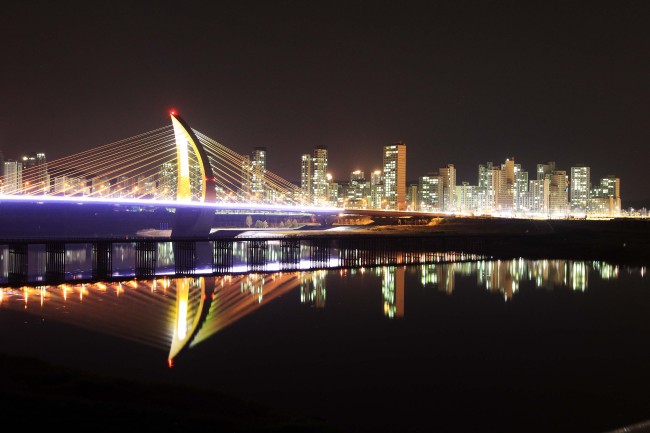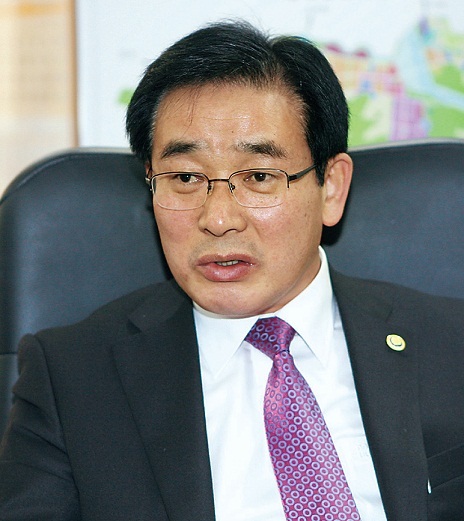This is the second in a series of articles on Sejong City, a new multifunctional administrative city to be launched on July 1. ― Ed.
As the official opening of Sejong City draws near, Song Ki-sup’s days are getting busier as he tries to make things right and ready.
Much of the new city is still under construction and is expected to remain so for some years to come, as its development plan spans decades.
Yet, the city is readying a charm offensive that highlights its unparalleled living environment, which Song and other officials hope will help dispel lingering doubts over the new administrative hub.
“Sejong is a city that the government and its land and housing development arm, LH Corp., are building with 22.5 trillion won of funds,” said the chairman of the Multifunctional Administrative City Construction Agency. “It is planned as a futuristic, green city with a top-class living environment and ubiquitous educational infrastructure,” he said in the interview with The Korea Herald.
As the official opening of Sejong City draws near, Song Ki-sup’s days are getting busier as he tries to make things right and ready.
Much of the new city is still under construction and is expected to remain so for some years to come, as its development plan spans decades.
Yet, the city is readying a charm offensive that highlights its unparalleled living environment, which Song and other officials hope will help dispel lingering doubts over the new administrative hub.
“Sejong is a city that the government and its land and housing development arm, LH Corp., are building with 22.5 trillion won of funds,” said the chairman of the Multifunctional Administrative City Construction Agency. “It is planned as a futuristic, green city with a top-class living environment and ubiquitous educational infrastructure,” he said in the interview with The Korea Herald.

He has been leading the MACCA, a special governmental body that oversees the planning and construction of Sejong, since November last year.
On Sunday, the government will officially proclaim the launch of Sejong City as the 17th metropolitan autonomous entity in Korea.
Located some 120 kilometers south of Seoul, Sejong is to be home to a total of 36 central government offices and 16 other state-run organizations.
The first to move is the Prime Minister’s Office in September, followed by 11 other ministries and agencies near the end of the year.
“Preparations are well under way to accommodate an influx of new residents,” Song said. “Construction for government buildings is also on schedule.”
People have already started to move into the city.
Sejong’s first residential district, opened late last year, now has about 2,200 households and four schools. Some 4,300 families are to move in the next few months, Song said.
“Our goal is to make Sejong a place that people want to live in,” Song said.
He gave a number of reasons why he thinks it’s possible.
Located in the heart of the country, Sejong is reachable within 2 hours from any major cities, including Seoul.
“To ensure the 2-hour accessibility, over 2.78 trillion won will be spent on roads linking Sejong to 13 major cities,” Song said.

The city’s world-class educational infrastructure will be another key attraction, he went on.
Schools in Sejong will be a model of future schools in Korea, with innovative use of technology in classrooms, eco-friendly environments and the number of students per class capped at 20-25.
“Sejong is designed as a green city, with over 52 percent of its land set aside for parks, lakes and green space,“ Song said.
That is by far the highest percentage of green space compared to any city in Korea. The figures for Bundang and Ilsan, two of the most recently-built residential towns, stand at about 20 percent.
The city is also designed to deploy a maximum of alternative energy and minimize carbon dioxide emissions.
Solar, geothermal and other renewable energy are projected to make up 15 percent of the city’s total power consumption by 2020.
“Sejong City will not only be a hub of central government. It will grow into a new national center, driving the development of central regions,” Song said.
By Lee Sun-young (milaya@heraldcorp.com)
-
Articles by Korea Herald



















